Prof. Eric Benbow Receives NIH-NSF Grant to Probe Mysterious Tropical Disease
October 13, 2005
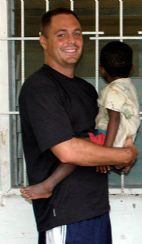 October 13, 2005, Greencastle, Ind. - A $2 million multidisciplinary grant from the National Institutes of Health (NIH) and National Science Foundation (NSF) will fund research by M. Eric Benbow, assistant professor of biology at DePauw University, into a mysterious tropical skin disease. Benbow and Richard Merritt, chair of the department of entomology at Michigan State University, will probe possible links between biting aquatic insects, water quality and transmission of Buruli ulcer disease. Benbow served as a research associate to Merritt at MSU. (photos taken during a preliminary research trip for the project in Ghana, Africa; image at left shows Prof. Benbow at orphanage)
October 13, 2005, Greencastle, Ind. - A $2 million multidisciplinary grant from the National Institutes of Health (NIH) and National Science Foundation (NSF) will fund research by M. Eric Benbow, assistant professor of biology at DePauw University, into a mysterious tropical skin disease. Benbow and Richard Merritt, chair of the department of entomology at Michigan State University, will probe possible links between biting aquatic insects, water quality and transmission of Buruli ulcer disease. Benbow served as a research associate to Merritt at MSU. (photos taken during a preliminary research trip for the project in Ghana, Africa; image at left shows Prof. Benbow at orphanage)
Buruli ulcer disease (BU) is the common name for Mycobacterium ulcerans Infection. "This is a disfiguring skin disease that is rapidly emerging in tropical regions of the world, most profoundly in West Africa," Professor Benbow states, noting that 70% percent of BU patients are children under 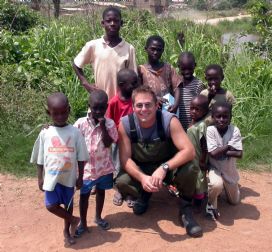 15 years old. "Outbreaks of BU are nearly always associated with slow-flowing aquatic habitats, which many times are affected by, or created from, human-made changes to the landscape."
15 years old. "Outbreaks of BU are nearly always associated with slow-flowing aquatic habitats, which many times are affected by, or created from, human-made changes to the landscape."
The research project is aimed at solving the mystery of how BU is transmitted. Patients who contract a Buruli ulcer infection and fail to seek treatment face the destruction of tissue, muscle and even bone, and may lose limbs to amputation.
"Our interdisciplinary study will take a novel approach to examining the spatial and temporal patterns of human environmental disturbance on the ecology of aquatic food webs, and will model how these changes interact with M. ulcerans ecological distribution and potential for causing disease," Benbow notes. The professor, in his first year teaching at DePauw, will collect data from sites in Ghana, Africa, and will involve his students in the 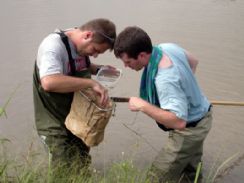
"DePauw students will contribute to sample collections, sample processing and data analysis for predicting ecological relationships that contribute to the emergence of this bacterial pathogen, making a substantial contribution to our understanding of broader patterns in disease ecology," he says. "Students will also develop independent research projects that assess food web dynamics and feeding preferences of aquatic insects thought to play a role in M. ulcerans transmission to humans. Students will use insect species from the Midwest to better understand food web dynamics similar to those in endemic-disease regions of Africa. These experiments will complement the larger project by providing data into feeding 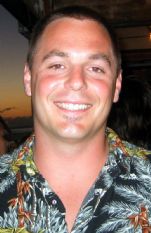 patterns and potential bacterial movment pathways in standing aquatic waterbodies such as wetands and swamps. These projects will also evaluate the structural and functional differences in aquatic food webs between temperate and tropical standing water ecosystems."
patterns and potential bacterial movment pathways in standing aquatic waterbodies such as wetands and swamps. These projects will also evaluate the structural and functional differences in aquatic food webs between temperate and tropical standing water ecosystems."
Eric Benbow's project is one of eight that the NSF and NIH have announced under the Ecology of Infectious Diseases (EID) Program. "The joint NSF-NIH program supports efforts to create a predictive understanding of the ecological and biological mechanisms that govern relationships among human-induced environmental changes and the emergence and transmission of infectious diseases," the agencies note. "Interdisciplinary projects funded through the EID program will study how large-scale environmental events -- such as habitat destruction, biological invasion and pollution -- alter the risks of viral, parasitic and bacterial diseases emerging in humans and animals. These studies will allow public-health officials, wildlife managers and farmers to control the spread of diseases among humans, domestic and wild animals, and crops, say EID scientists."
"The role of biological diversity and habitat structure in stabilizing communities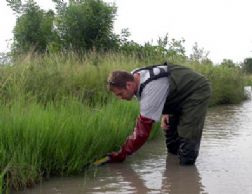 of plants, animals and microorganisms has received a great deal of attention from ecologists in recent years," says Sam Scheiner, EID program director at NSF. "As a result, our capacity to analyze and model biocomplexity and ecological dynamics, and to evaluate spatial and temporal aspects of environmental change, have become increasingly sophisticated. However, few of these advances in the ecological sciences have yet contributed to biomedical research or to public health. That's where the joint NSF-NIH EID program comes in."
of plants, animals and microorganisms has received a great deal of attention from ecologists in recent years," says Sam Scheiner, EID program director at NSF. "As a result, our capacity to analyze and model biocomplexity and ecological dynamics, and to evaluate spatial and temporal aspects of environmental change, have become increasingly sophisticated. However, few of these advances in the ecological sciences have yet contributed to biomedical research or to public health. That's where the joint NSF-NIH EID program comes in."
Read more by clicking here and here. News of the grant is also noted in a story at Michigan State's Web site.
Back